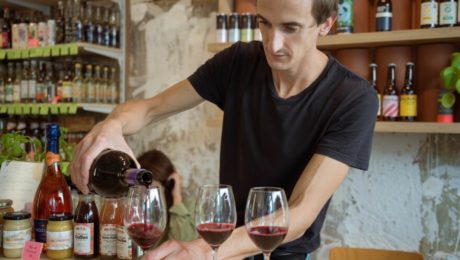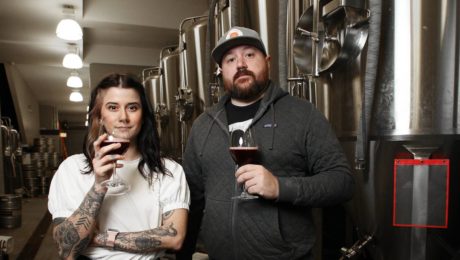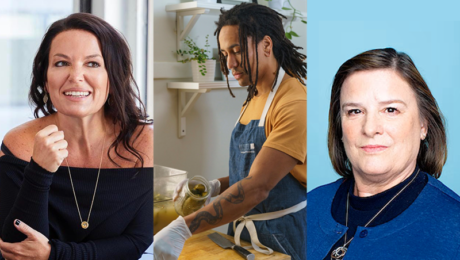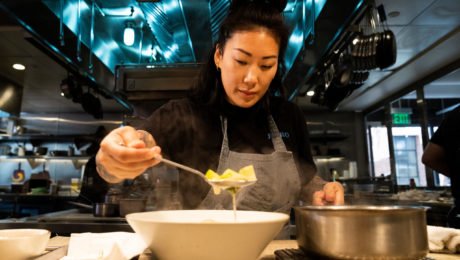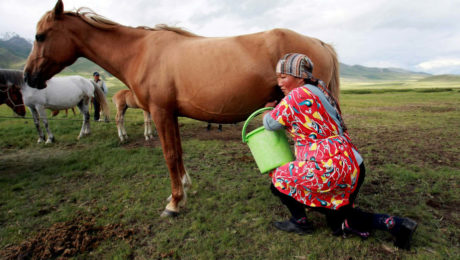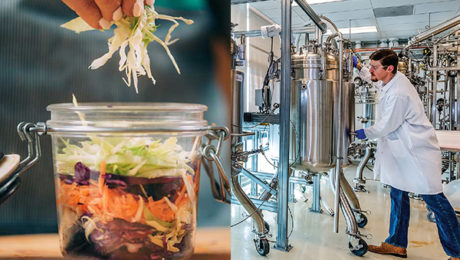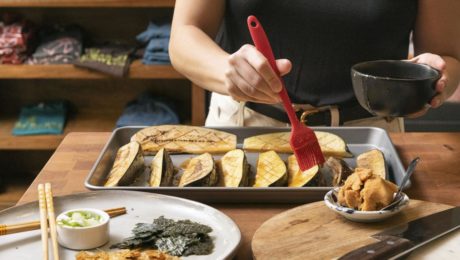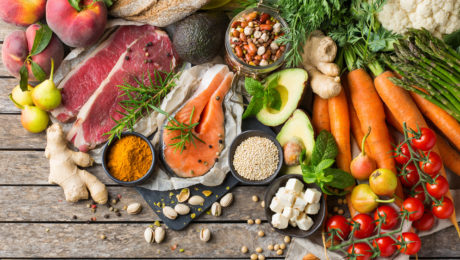Non-Alcoholic Wine: “This is definitely not a fad”
The first non-alcoholic wine shop has opened in Paris. An NPR article questions: Will the French actually drink their products?
Alcohol-free wine and liquor shop Le Paon Qui Boit (translation: The Drinking Peacock) opened in April, the brainchild of lawyer Augustin Laborde. The shop sells more than 300 bottles of low- and zero-proof beers, wines, gins and whiskeys. Laborde quit drinking during the pandemic and was frustrated going to bars with friends and finding his only non-alcoholic options were sugar-filled sodas or fruit juices.
The bottles have high price tags in Paris, at 10 to 15 euros (compared with 4 to 8 euros for an alcoholic version). Laborde says there are extra steps involved in making a non-alcoholic wine. After going through traditional fermentation, the alcohol in wine is evaporated through a filtration process.
Non-alcoholic wine consumption globally has grown 24% in the last year, according to consulting group IWSR Drink Market Analysis. Dan Mettyear, research director at IWSR, says “This is definitely not a fad…it’s all connected to the kind of big wellness trends that we’ve seen across the world.”
Growth, though, has been slower in France than in the U.S. and the rest of Europe. He says it’s a harder sell in traditional wine markets like France. “A lot of people have already well-established ideas about what wine is and what wine should taste like.”
But there are wineries transitioning to the production of non-alcoholic wines, such as Le Petit Béret, a small producer in southern France. And Laborde says he anticipates the flavor of non-alcohol wine to become more refined, as techniques improve and the market grows.
Read more (NPR)
- Published in Food & Flavor
Chicago: A Fermentation Hub
If you still think of hot dogs and deep dish pizza as the icons of Chicago’s culinary scene, you need to think again. The so-called Capital of the Midwest is a hub of innovation in the food industry. Chicago has the largest food and beverage production in the U.S., with an annual output of $9.4 billion. Food startup companies in the region raised $723 million in venture capital last year.
“Chicago is one of the most diverse cities for eating,” says Anna Desai, Chicago-based influencer of Would You Like Something to Eat on Instagram. ”Our culinary scene is constantly elevating and evolving. We are always just a neighborhood or tollway away from experiencing a new culture and cuisine. I’m most excited when I find an under-the-radar spot or discover a maker who can pair flavors and ingredients that get you curious and wanting more.”
Desai started her blog in part because she wanted to champion the Asian American and Pacific Islanders (AAPI) community in the Chicago food and beverage scene. “Food has long served as a cultural crossroad,” she adds, and Chicago’s multicultural cuisine exemplifies that sentiment.
Chicago is home to some of the most creative minds in fermentation, from celebrity chefs, zero waste ventures, alternative protein corporations and the world’s largest commercial kefir producer. There are dozens of regional and artisanal producers lacto-fermenting vegetables, brewing kombucha and experimenting with microbes in food and drink.
“Chicago is a great food city in its own right, so naturally there is a ton of talent in the fermentation space,” says Sam Smithson, chef and culinary director of CultureBox, a Chicago-based fermentation subscription box. “The pandemic’s effect on restaurants has also spawned a new wave of fermenters (ourselves included) that are looking for a path outside the grueling and uncertain restaurant structure to display our creative efforts. This new wave is undoubtedly community-motivated and concerned more with mutual aid than competition. There is a general feeling that we are all working towards the same goal so cooperation and collaboration is soaring and we are seeing incredible food come from that.”
Flavor is King
Flavor development is still the prime motivation for chefs to experiment with fermentation. A good example is at Heritage Restaurant and Caviar Bar in Chicago’s Humboldt Park neighborhood.
“Fermentation has been a cornerstone of the restaurant since its inception,” says Tiffany Meikle, co-owner of Heritage with her husband, Guy. “With the diverse cuisines we pull from, both from Eastern and Central Europe and East Asia, we researched fermentation methodologies and histories, and started to ‘connect the dots’ of each culture’s fermentation and pickling backgrounds.”
Menus have included sourdough dark Russian rye bread, toasted caraway sauerkraut, kimchi made from apples, Korean pears and beets and a kimchi using pickled ramps (wild onions). Heritage has also expanded their fermentation program to the bar, where they’ve created homemade kombucha, roasted pineapple tepache, sweet pickled fruits for cocktail garnishes, and kimchi-infused bloody mary mix.
“It’s fascinating to me that there are so many ingredients you can use in a fermented product,” says Claire Ridge, co-founder of Luna Bay Booch, a Chicago-based alcoholic kombucha producer. “People are really experimenting with interesting ingredients in kombucha…I have seen brewers do some of the wildest recipes and some recipes that are very basic.”
Innovating Food
Chicago-based Lifeway Kefir is indicative of the innovation taking place in the city. Last year the company expanded into a new space: oat-based fermentation, launching a dairy-free, cultured oat milk with live and active probiotics.
“We’ve spent so many years laying the groundwork in fermented dairy,” says Julie Smolyansky, CEO. “Now we’re experimenting and expanding to see what’s over the next horizon, though we’ll always have kefir as our first love.”
Chicago is home for two inventive fermented alternative protein startups: Nature’s Fynd and Hyfé Foods. Both companies were born out of the desire to create alt foods without damaging the environmental.
“Conscious consumerism is a trend that’s driving many people to try alternative proteins, and it’s not hard to understand why,” says Debbie Yaver, chief scientific officer at Nature’s Fynd. The company uses fermentation technology to grow Fy, a nutritional fungi protein. “Fungi as a source of protein offer a shortcut through the food chain because they don’t require the acres of land or water needed to support plant growth or animal grazing, making fungi-based protein more efficient to produce than other options.”
Alternative foods outlasting the typical trend cycle is a challenge for companies like Nature’s Fynd. When grown at scale, Fy uses 99% less land, 99% less water and emits 94% fewer greenhouse gasses than raising beef. But, to make an impact, “we need more than just vegans and vegetarians to make changes in their diets,” Yaver adds.
Waste Not
Numerous companies are using fermentation as a means to eliminate waste. Hyfé Foods, another player in the alternative protein space, repurposes sugar water from food production to create a low-carb, protein-rich flour. Fermentation turns a waste product into mycelium flour, mycelium being the root network – or hyphae (hence the company name) — of mushrooms.
“[We’re] diverting input to the landfill and reducing greenhouse gas emissions at scale,” says Michelle Ruiz, founder. “Hyfé operates at the intersection of climate and health, enabling regional production of low cost, alternative protein that reduces carbon emissions and is decoupled from agriculture.”
Symmetry Wood is another Chicago upcycler. They convert SCOBY from kombucha into a material, Pyrus, that resembles exotic wood. Founder Gabe Tavas says Pyrus has been used to produce guitar picks, jewelry and veneers. Symmetry uses the discarded SCOBY from local kombucha brand Kombuchade.
Many area restaurants and culinary brands also use fermentation to preserve food for the long Chicago winters, when local produce isn’t available. Pop-up restaurant Andare, for example, incorporates fermentation into classic Italian dishes.
“Finding ways to utilize what would otherwise be waste products inspired our initial dive into fermentation. The goal is not just to use what’s leftover, but to make it into something delicious and unique,” says Mo Scariano, Andare’s CEO. “One of our first dishes employing koji fermentation was a summer squash stuffed cappellacci served with a butter sauce made from carrot juice fermented with arborio rice koji. Living in a place with a short grow season, preservation through fermentation allowed us access throughout the year to ingredients we only have fresh for a few weeks during the summer.”
Industry Challenges
Despite growing interest and increasing sales, fermenters face some significant hurdles.
Smithson at CultureBox says he sees that consumers are open to unorthodox, less traditional ferments. Though favorites like kombucha and sauerkraut dominate the market, “their share is being encroached on by increasingly more varied and niche ferments.” But getting these products to market can be a challenge. Small-scale, culinary producers are challenged by the regulatory hoops they need to jump through to legally sell ferments – especially unusual ones a food inspector doesn’t recognize.
“The added layer of city regulations on top of state requirements, sluggish health department responses, and inflexible policy chill the potential of small producers,” Smithson says. But he highlights the recently-passed Home-to-Market Act of Illinois as positive legislation helping startup fermenters.
Consumer awareness and education are also vital. “Many longstanding and harmful misconceptions on the safety and value of fermented products still exist,” Smithson says.
Matt Lancor, founder and CEO of Kombuchade makes consumer education a core part of marketing, to align kombucha as a recovery drink.
“Most mainstream kombuchas are marketed towards the yoga/crystal/candle crowd, and I saw a major opportunity to create and market a product for the mainstream athletic community,” he says. “We’re on a mission to educate athletes and the general public about these newly discovered organs [the gut] – our second brain – and fuel the next generation of American athletes with thirst quenching, probiotic rich beverages.”
Product packaging provides much of a consumer’s education. Jack Joseph, founder and CEO of Komunity Kombucha, says simplicity is key.
“People are more conscious of their health now, more than ever before,” he says. “So now it comes down to the education of the product and creating something that is transparent and easy for the consumer to digest.”
Sebastian Vargo of Chicago-based Vargo Brother Ferments agrees.
“Oftentimes food is considered ‘safe’ due to lack of microbes and how sterile it is,” he says. “Fermentation eschews the traditional sense of what makes food ‘safe’. We need to create a set standardized guide for fermented food to follow, and change our view of living foods in general. One of the brightest spots to me is the fact that fermentation is really hitting its stride and finding its place in the modern world, and I don’t see it going anywhere but up in the near future.”
- Published in Business, Food & Flavor
Brewing Boom in Chicago
Dubbed the craft beer capital of America, Chicago has a brewery scene that is innovative and diverse. Numerous breweries have opened over the last decade, with now about 160 breweries across the city and surrounding suburbs. Ferment Magazine says Chicago’s craft brew industry is “one of the most expressive and most exciting experiences anywhere in the world, let alone in the U.S.”
“We have a very strong culinary scene in Chicago and a lot of consumers that have an open mind. There’s a lot we could throw at the market and people are very accepting of the different brewing styles, both old world and new world,” says Tyler Davis, founder and director of fermentation at Duneyrr Artisan Fermenta Project. “Of all the [different beer styles] we could produce, there are brewers in Chicagoland that specialize in that.”
Chicago’s Brewers
Duneyrr (pictured) focuses on co-fermentation. Using craft beer as a base, Davis makes fermented drinks with ingredients from wine, cider and mead.
“It all came from me reaching the end of my creativity in a brewery. I got tired of creating the same format,” says Davis, who worked in Chicago as head brewer at Lagunitas and at Revolution Brewing. He began experimenting with co-fermentation and found “how you ferment wine is shockingly similar to beer. There are nuances of both, but I enjoy blurring the lines.”
The Nordic-inspired drinks he produces include his favorite, Freya Franc,(a sour hybrid with passion fruit and Sauvignon Blanc grape must. Duneyrr also has a Moderne Dune line, a sister brand that specializes in modern ingredients and techniques.
Davis studied at the Chicago-based Siebel Institute of Technology, the oldest brewing school in the U.S. and alma mater to many area brewers. One alum is Dave Bleitner, who founded Off Color Brewing with his Siebel classmate, John Laffler. The two focus on funky fermentation.
“Even with our first flagship gose, Troublesome, we have always been fermentation-focused. Even when we are dumping in a bunch of rooibos tea and pumpkin pie spices into a beer, we believe beer needs a proper fermentation to work,” Bleitner says. “Maximizing flavor from yeast is always going to result in a superior beer. But beyond our focus on fermentation, we are not afraid to dump a bunch of rooibos tea and pumpkin pie spices into a beer. So the dual concepts of focusing on the basics of fermentation while teetering on the border of innovative and insane is something no one else should or can replicate.”
When Off Color launched in 2013, Bleitner and Laffler didn’t want to go the mainstream craft beer route. “We had some crazy idea that craft beer consumers wanted variety from their beer,” Bleitner said. They didn’t follow the usual craft beer formula of launching with an IPA. They started with lesser-known styles like gose and kottbusser. He notes “we really hit our stride with Apex Predator Farmhouse Ale.”
At 15 years old, Half Acre Beer is one of Chicago’s pioneers of the craft beer scene. The brewery is the third-largest independent brewer in Illinois and now distributes their beer all over the country. They run a brewery and taproom in Chicago. Their best seller is Daisy Cutter pale ale, but they also sell seasonal and monthly varieties.
“These days we’re kind of the older, bigger brewery among the smaller, newer breweries. We focus on hop-forward and traditional beers,” said Gabriel Magliaro, president of Half Acre. He echoed the sentiment expressed by Duneyyr and Off Color – Chicago brewers are a supportive community. “Today I think we can call Chicago a beer town and, no matter how you choose to define that, we show up well.”
The Next Beer Buzz
Craft beer brewers see increasing competition from the better-for-you, healthier fermented drinks, like kombucha, seltzer and low- or non-alcoholic beverages.
Duneyrr is starting to specialize in lower-alcohol fermented brews. Off Color, too, has added a lower-alcohol beer, a 2.5% ABV Belgian-style they call Beer for Lightweights.
Lagers are making a comeback as well. “A lot of old world brewing styles, there’s become a renaissance,” Davis says. He sees “candy beers” – filled with artificial flavors – going away. Bleitner, too, is not a fan – he calls hard seltzers “fermented pixie sticks”. But he’s found that consumers like flavor in their brews. When sales of Off Color’s Troublesome gose began to decline, adding lime juice revived the drink. They called it Beer for Tacos and “it took off almost immediately.”
In an era fraught with pandemic shutdowns, retail inflation and supply chain issues, brewers foresee challenges ahead.
“Obviously the pandemic has been a factor, one that is still playing out,” Magliaro says. “The on-premise was rocked and I don’t think anyone knows how that will look in five years.”
Climate change is affecting grain crops, “things we knew to be stable are now being highly influenced by the weather patterns,” Davis says. The hot weather is changing the nutrient level of grains, leading to grains higher in protein. “It’s pretty scary,” he says.
But beer will always find a way to thrive.
“We make something embedded in human culture,” Magliaro says. “Beer is a gathering liquid that has place almost anywhere for almost any occasion with so much heritage to its being. The industry, consumer landscape and world can do what it needs, but beer will live on.”
- Published in Business, Food & Flavor
Bubbling Over: Chicago Fermentation Scene
In anticipation for our conference FERMENTATION 2022 in Chicago, TFA asked over a dozen area fermenters about what they love about the city’s fermentation scene. Their answers touched on a number of points: creativity in foods and beverages, diverse offerings, scrappy and determined founders, supportive community and evolving foodscape.
Below are the answers from three local fermentation experts – kefir company founder Julie Smolyansky (Lifeway Kefir), local ferments producer Sebastian Vargo (Vargo Brother Ferments) and chief scientific officer Debbie Yaver, PhD (Nature’s Fynd).
The question: What do you love about the Chicago fermentation scene?
Julie Smolyansky, Lifeway Kefir
Chicago is a true melting pot. We have diversity, talent, and lots of skilled manufacturing talent. It’s one of the premier food cities in the world and I’m so grateful that we’ve been able to build our business and community in Chicago. The natural foods, fermentation, and dining scene all commingle to create opportunities for a special type of risk-taking that’s uniquely Chicago. Lots of it bubbles under the radar – who would have guessed that the kefir capital of the United States is in the Midwest?
Sebastian Vargo, Vargo Brother Ferments
I love the fact that we are seeing more fermentation than ever, from restaurants to store shelves to folks starting projects at home. I love the community behind it, folks are sharing recipes and exchanging tips and tricks. People don’t have time for gatekeeping anymore.
Debbie Yaver, Nature’s Fynd
I love that it flips the script. For so long Chicago was known as the “Hog Butcher to the World,” but now one of the oldest technologies in the books is experiencing a renaissance. There are lots of companies utilizing traditional fermentation, but not as many in the food space. It’s exciting to be one of the newer kids on the block, to see how different companies are putting fermentation to work, and to get to pull from such a stocked talent pool. Chicago is full of bright minds with deep fermentation experience.
- Published in Food & Flavor
Can Science Improve Chocolate?
Just like wine and coffee, the flavors of chocolate come from the local terrain, climate and soil where the cacao bean is grown. Chocolates from various parts of the world all taste different. Can those tastes be replicated?
Scientists are trying to determine what produces those flavors and if they can reproduce them consistently. Irene Chetschik, professor in food chemistry at Zurich University of Applied Sciences, has developed “new technological processes that can impact cocoa flavor on a molecular level — to get the best out of each harvest and create consistent quality,” details an article in BBC.
Chetschik says: “Now there is more appreciation for the product – we know where the bean is coming from, which farm, which variety – we can experience a much wider flavor diversity.”
Cocoa beans traditionally are fermented where they are grown. Fermentation will affect quality – a poorly-fermented bean has little flavor; while an over-fermented bean can become too acidic.
Chetschik has developed a “moist incubation” fermenting technique where a lactic acid solution containing ethanol is applied to dried cocoa beans. It triggers the same fermentation reaction in the beans, “but is far easier to control,” she says. The final taste is sweet, rich and fruity.
Nottingham University is also working on a chocolate-enhancing project. They’re using a hand-held DNA sequencing device to analyze the cocoa bean microbes. “With improved understanding of what drives the taste of premium chocolate, fermentation can be manipulated for improved flavor.”
Read more (BBC)
- Published in Food & Flavor, Science
“Koreanique” Food
As more Korean adoptees come of age to run restaurants, a new dining style is emerging: “Koreanique” (or Korean-style, Korean-inspired or “kinda Korean”).
“For these chefs, cooking is the ultimate reclamation of their Koreanness — and an act that pushes the cuisine to exciting places,” reads an article in The New York Times.
They produce dishes that “reflect their American upbringings and Korean heritage” of the adoptee chefs. Examples are: Jewish matzo ball soup with Korean mirepoix, Spam musubi burritos, kimchi-enriched carbonara, chicken marinated in kimchi brine, battered fish-sauce-laden zucchini with a sweet soy dipping sauce, jajangmyeon sauce with Bolognese and gochujang barbecue sauce.
Still, they note, feelings of imposter syndrome and cultural appropriation can take over. Adoptee chefs tell The Times they worry they’re not making Korean food authentically and they struggle with their complicated relationships with Korean food when they grew up eating a different culture’s food.
Read more (The New York Times)
- Published in Food & Flavor
Would You Drink Fermented Horse Milk?
The country of Kyrgyzstan is hoping to attract tourists by highlighting traditional kumis – fermented mare’s milk. Locals drink and bathe in the liquid for health benefits. Promotional films romanticize a visit to the Asian country, highlighting how one can experience the nomadic Kyrgyz lifestyle by sleeping in a mountain yurt near herds of horses.
“We decided to try it after hearing about saamal (another word for mare’s milk) and kumis from our friends who had visited Kyrgyzstan,” says Ibrahim al-Sharif, a tourist from Mecca, Saudi Arabia, in a CNN Travel article. “I cannot even describe its taste. There is nothing in Saudi Arabia that I would compare with it.”
CNN notes “milking a mare is far trickier than milking a cow.” A person must be big enough to reach their arms around the horse’s thigh. A milking is not done year round but in mid-May and mid-July, traditionally ending when the Pleiades star cluster appears.
Read more (CNN)
- Published in Food & Flavor
Will Fermentation Connect Gastronomy and Biotech?
Fermentation is motivating scientists to listen to gastronomers, a rare occurrence in the field of science.
“There’s going to be a huge exchange in this two-way road that we’re living in. Innovation in flavor coming from gastronomy and innovation coming from a high-level biotechnology, they are going to be harmonious,” says Jason White, director of the fermentation lab at Noma in Copenhagen. “We’re going to be able to create this infrastructure and community of people who have the same goal, and the same goal is going to be the wellness of our planet.”
White spoke at the 2nd international Food Innovation Conference. This annual gathering of industry experts is produced by the Gottlieb Duttweiler Institute (GDI), Switzerland’s oldest independent think tank, which researches the future of food, retail and health.
The conference focused on the future of fermented alternative proteins. Or, as GDI puts it: “how innovation can solve the carnivore conundrum.” Speakers included the founders of numerous precision fermentation companies, such as SuperBrewed Food, Bosque Foods, Melt&Marble and WNWN Food Labs.
“We do the same thing, we just have different outputs”
Fermentation for alternative proteins is a divisive topic among traditional fermenters. Many say it’s lab-created fake food. Advocates, though, argue precision fermentation using DNA from mammals (as with Impossible Foods’ heme protein burger) and biomass fermentation of fast-growing, naturally-occurring organisms(e.g., Nature’s Fynd fungi protein) are reducing the risk of a global food crisis. Meat consumption is increasing, but animal meat is environmentally inefficient to raise. The significant amounts of agricultural land, fertilizer, pesticide and hormones needed to raise animals for meat protein release harmful carbon emissions.
The chefs on GDI’s “Fermentation: A World Within Gastronomy” panel spoke favorably of using fermentation for alt foods. White was joined by Ezio Bertorelli, co-founder of fermentation shop Meta Copenhagen, and Sirkka Hammer, founder of food manufacturer Wiener Miso in Austria.
“I think that it’s important for us not to steer too far away from the origins of fermentation,” White notes. But, “whether you have this bioreactor filled with whatever working inside of a laboratory with a team of scientists, we are still creating something that comes from microorganisms and from organisms. And so we do the same thing, we just have different outputs, different audiences.”
Precision fermentation technology is rooted in traditional fermentation, he notes. You need to understand the abilities of microbes and composition of ingredients for a successful precision fermentation.
“Inside of these laboratories and restaurants, there’s so many things that are being discovered that stop at the guest experience,” White says of fermentation. Today, as fermentation continues a revitalization as a kitchen craft, it’s utilized by more people rather than just chefs and scientists.
DIscovering Fermentation
Hammer highlighted the boom in home fermentation, with people creating the bold flavors of fermented foods and beverages on their own countertops.
“There’s a certain magic in fermentation. That’s why you’re gripped with it,” she says. “People are bringing a little bit of that magic, uncontrollable magic maybe [into their homes].”
At Wiener Miso, Hammer launched the company’s umami-driven ferments after living in Asia for more than a decade. The spices, pastes and sauces she makes are based on traditional Japanese ferments.
“Fermenting gives you in gastronomy next level or an add-on of flavors and textures,” she says. “Fermentation really changes the texture in a different way than if you cook it or freeze it. It gives it new dimensions.”
Flavor is what introduced Bertorelli to fermentation, too. His background is in professional cooking – he is the former executive chef of La Petite Table in Paris – but he was always experimenting with miso and sauerkraut in his home kitchen.
Even today, his fermentation experiments “go terribly wrong most of the time,” says Bertorelli. Only about 5% are successes, “that’s what makes it exciting.”
“Fermentation really changed my life because it showed me most of the dishes I was passionate about, the origin of the flavor, was the fermented part,” he says. “Flavor is universal… If you have that mind-blowing moment, it can reconnect you with things that are inside all of us, like our ancestors have been eating these foods since thousands of years ago and it’s sort of like going back in time while still being here.”
- Published in Food & Flavor
The Unsung History of Umami
In the early 1900s, Japanese chemist Dr. Kikunae Ikeda discovered the flavor umami by distilling it from soup stock. That compound – which is an amino acid, glutamate — produces the savory flavor in meat, mushrooms and seaweed. Ikeda called the flavor after the Japanese word umami which means “essence of deliciousness.”
“It is the peculiar taste which we feel as umai, meaning brothy, meaty or savory, arising from fish, meat and so forth,” Ikeda wrote in the Journal of Tokyo Chemical Society.
A huge discovery, umami became the fifth flavor next to salty, sweet, sour and bitter. Ikeda went on to start a company, Ajinomoto, which mass produces monosodium glutamate — MSG — a key ingredient in producing umami.
But it took nearly 100 years for umami to be recognized by the broader scientific community, especially in the western world. An NPR story points to the anti-Asian “Chinese Restaurant Syndrome” which began in the 60s and 70s. MSG was vilified as an unhealthy additive, numbing mouths and making people sick (an apparent fable modern food scientists have never been able to prove). Another reason: umami research may have been ignored in the U.S. because of tension with Japan during World War II .
“Fermented foods and seasonings like sake, soy sauce, miso were a large part of the diet in Japan and also a large part of the economy. And so research into the flavor components of those kinds of foods were an important part of rationalizing diet in Japan.”
says Victoria Lee, professor and author of “The Arts Of The Microbial World.”
Read more (NPR)
- Published in Food & Flavor
Dietitians Say: Nordic Diet Healthiest Option
The Nordic Diet is getting more attention from dietitians, who are encouraging clients to embrace a range of fruits, vegetables, fish and fermented food and drink.
“’The Nordic diet features a large variety of foods, without any strict restrictions, which are key to a sustainable way of eating,” says Tamara Willner, London-based nutritionist.
Though the Mediterranean diet has dominated dietitians’ wellness advice, the Nordic diet is a heartier option. It includes seasonal foods that thrive in colder climates, like root vegetables – beets, carrots, turnips – and fruits – plums, apples and berries. Fish like herring are also recommended. Fermented food is a key differentiator between the two diets – kefir, fermented fish and fermented vegetables are prominent in Nordic countries.
“Our gut hosts a huge number of gut microbes that feed off the foods we eat and produce more bacteria,” Willner continues.
The Nordic diet is cheaper to maintain, too. The produce is generally less expensive and the Nordic diet relies on whole grains, beans or lentils.
Read more (Daily Mail)
- Published in Food & Flavor

